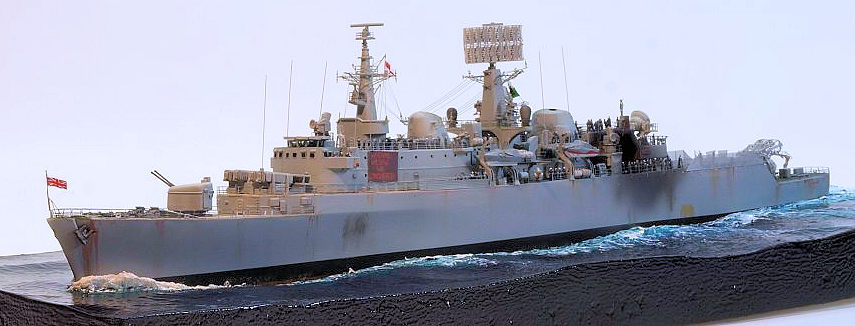
Atlantic Models 1/350 HMS Glamorgan
| KIT #: | ATK 35004 |
| PRICE: | £176.50 |
| DECALS: | Yes |
| REVIEWER: | Frank Spahr |
| NOTES: | Resin kit with p.e., cast metal parts and wire |

| HISTORY |
HMS Glamorgan belonged to the eight vessels of the County Class, Britain´s first guided missile destroyers. The vessels´ main armament was the Seaslug anti aircraft missile. This very heavy missile was powered by a sustainer rocket engine and accelerated by four solid fuel boosters that separated after launch. It needed constant guidance by a type 901 radar, so only one target could be engaged at a time. A large latticework twin launcher dominated the ship´s quarterdeck, whilst a large part of the hull was used for missile storage and launch preparation. Any missile needed final assembly of its control surfaces and boosters prior to launch.
Given these requirements, the Counties ended up as very large ships, and might reasonably have been termed cruisers. They had space enough to house an admiral and his staff, so were frequently used as flagships. Their COSAG powerplant combined steam and gas turbines. A helicopter hangar was added later in the project. It was rather cramped and poorly accessible from the port side only, but fitted a Wessex ASW helicopter.
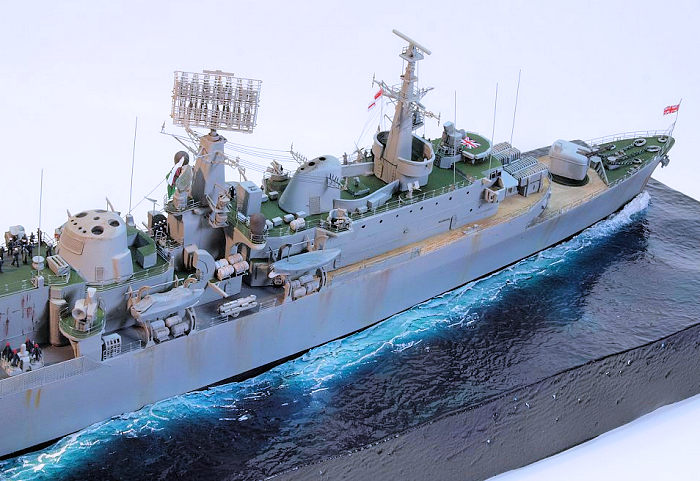 Two twin
4.5 inch gun turrets in A and B position, two quadruple Seacat missile launchers
and two 20 mm Oerlikons completed the armament. Not all of the ships had two
triple lightweight torpedo launchers.
Two twin
4.5 inch gun turrets in A and B position, two quadruple Seacat missile launchers
and two 20 mm Oerlikons completed the armament. Not all of the ships had two
triple lightweight torpedo launchers.
During the Counties´ service, the Seaslug soon became obsolete. In fact, it was only once used in anger against an aircraft, which it missed. The considerable weight of the missile sparked its use against land targets during the 1982 Falklands War, where it at least had a psychological impact on the opponents.
The major modification performed on the Counties was the substitution of B turret against four Exocet launch canisters. Apart from that, the electronics were updated to some degree and the boat complement reduced from six to four.
The four vessels of the first batch were decommissioned during the 1970s; of the four batch 2 vessels, Antrim and Glamorgan served in the Falklands War. All four were sold to the Chilean navy between 1982 and 1987, where they were refitted and served into the new millennium. Meanwhile, all of them have been scrapped.
The event shown
HMS Glamorgan´s involvement in the Falklands war began in late 1981. She was scheduled to serve on the so-called Armilla patrol in the Persian Gulf. On her way into the area the British task group was granted time for an exercise with a USN carrier battle group. At the time, Admiral "Sandy" Woodward flew his flag aboard Glamorgan. Woodward set the exercise that his task group was to attack the US carrier from outside a circular exclusion zone.
In his book "One Hundred days", he describes how he managed by clever use of lights and radio contact, to bring Glamorgan in strike distance for an Exocet attack on USS Coral Sea and "sunk" her. The problem should be mirrored only few months later when Woodward commanded the British carrier battle group and ordered the attack that sank the Argentine cruiser General Belgrano.
 The day
after this exercise, Glamorgan anchored in a poorly charted bay off the coast of
Oman. Despite numerous soundings, the vessel lay right above an uncharted rock,
and upon leaving her anchorage, damaged both propellers. That put an end to the
deployment, and after emergency repairs, she returned home for proper repairs.
The threat of a court martial hung over her commanding officer, Captain Mike
Barrow, and her navigator, Lt. Cdr. Ian Inskip, until it was finally cancelled.
That only happened in May, whilst the ship was already in the South Atlantic.
The day
after this exercise, Glamorgan anchored in a poorly charted bay off the coast of
Oman. Despite numerous soundings, the vessel lay right above an uncharted rock,
and upon leaving her anchorage, damaged both propellers. That put an end to the
deployment, and after emergency repairs, she returned home for proper repairs.
The threat of a court martial hung over her commanding officer, Captain Mike
Barrow, and her navigator, Lt. Cdr. Ian Inskip, until it was finally cancelled.
That only happened in May, whilst the ship was already in the South Atlantic.
After repairs and working up, Glamorgan sailed for Gibraltar in mid March, 1982, for the annual large scale fleet exercises termed "Springtrain". During the exercise, Argentina invaded the Falklands, trying to end the long-standing dispute about the sovereignity of the islands by force. When the British government decided to send a fleet into the South Atlantic to retake the islands, many of the vessels already at Gibraltar were used, Glamorgan amongst them. During the voyage South, she was used as flagship by Admiral Woodward, before he transferred his flag to the aircraft carrier HMS Hermes.
During the fighting for the Falklands, Glamorgan was mainly employed for shore bombardment duties with her remaining twin 4.5 inch turret. On 1 May, off Port Stanley, two 1,000 lb bombs closely missed her stern, causing some damage to her propulsion gear, but leaving it fully functional.
After numerous nights spent on shore bombardment duties, Glamorgan was withdrawn for eleven days to a sea area devoted to repair and maintenance. She returned to the gun line on 11 June for yet another night bombardment, supporting the British troops fighting their way closer to Port Stanley. That night´s designated target for the ship was Two Sisters Mountain. Glamorgan steamed along the gunline, trying to keep clear of a minefield, and trying not to hit any British troops. As the fighting drew on, Captain Barrow decided to stay longer than was ordered and considered advisable, and only left as the new day broke.
On her way back to the open sea, the ship was targeted by an Argentine missile unit. They operated a shipboard Exocet launcher improvisedly mounted on a truck. The missile was acquired by radar and an evasive manoeuvre ordered, but in the short time before impact the ship did not move fast enough to prevent a hit.
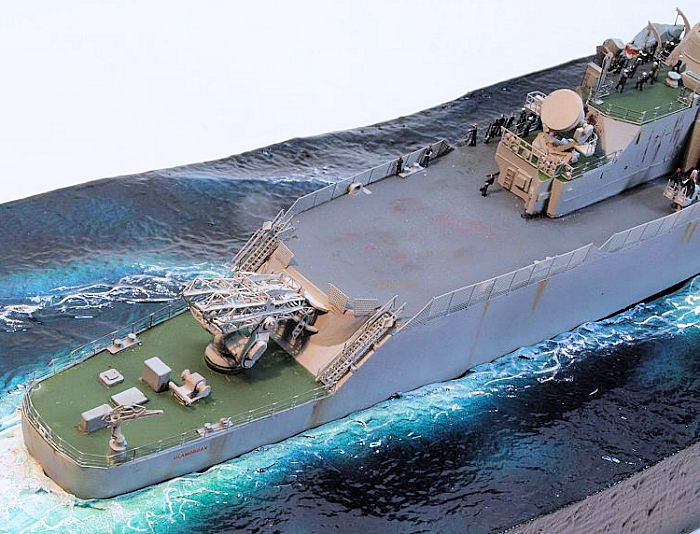 The
missile hit the ship from port on the deck next to the hangar door and blasted a
large hole into it. The fully fueled and ammunitioned helicopter in the hangar
exploded and the hangar burnt out to a shell. Burning fuel caused a devastating
fire in the galley area below the missile hit, and most of the 14 dead and 17
wounded were either galley or helicopter maintenance crew. Further fires broke
out in the gas turbine gear room, and there was the imminent danger of the fire
reaching the missile magazines. Water used for firefighting caused problems with
the ship´s stability, and it was a hard task to put the fires out and stabilize
the vessel. After four hours the fires were extinguished. The ship was able to
sail at reduced speed and returned to the carrier battle group.
The
missile hit the ship from port on the deck next to the hangar door and blasted a
large hole into it. The fully fueled and ammunitioned helicopter in the hangar
exploded and the hangar burnt out to a shell. Burning fuel caused a devastating
fire in the galley area below the missile hit, and most of the 14 dead and 17
wounded were either galley or helicopter maintenance crew. Further fires broke
out in the gas turbine gear room, and there was the imminent danger of the fire
reaching the missile magazines. Water used for firefighting caused problems with
the ship´s stability, and it was a hard task to put the fires out and stabilize
the vessel. After four hours the fires were extinguished. The ship was able to
sail at reduced speed and returned to the carrier battle group.
Emergency repairs were started immediately. The Argentinians surrendered on 14 June, after their position in Port Stanley had become untenable. On 18 and 19 June, further emergency repairs were performed on Glamorgan. She met the repair vessel Stena Seaspread in San Carlos Water, where the British had landed on 21 May.
On the 21st of June, Glamorgan left the carrier battle group for the long voyage home. She was accompanied by the frigate HMS Plymouth, which had also been damaged.
Glamorgan made a last and very close pass alongside the starboard side of Admiral Woodward´s flagship HMS Hermes, steaming at 24 knots and firing a 13-gun salute with live ammo from her gun turret. Many of her company manned her port rails, and a banner was displayed on her superstructure. She then returned uneventfully to the UK, arriving at Portsmouth on10 July.
I chose to model the moment of her final pass alongside Hermes, as it brings the overwhelming emotions of loss, trauma, professional pride, relief and release into focus which must have churned through the minds and hearts of her ship´s company. They were the first ship´s company that got away from an Exocet hit, and they got away from this war which was totally different from what they had come to expect during the Cold War. Reading the memoirs of Ian Inskip, he openly discusses his long-lasting trauma from his war experience, and he was just one of almost 500 men on this vessel alone.
| THE KIT |
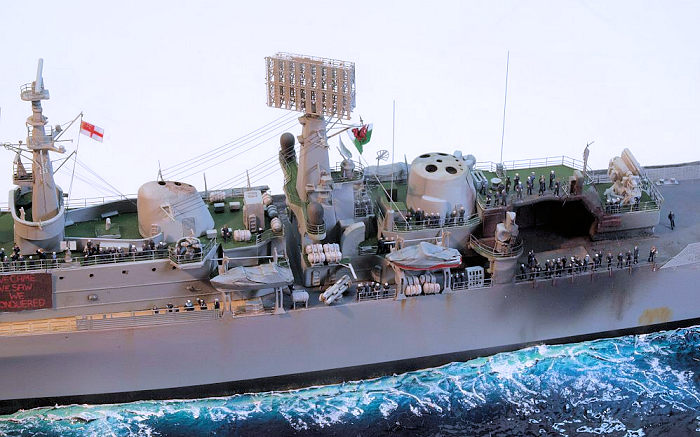 This
resin kit was first offered in 2013, and I got one pretty early on. It is what
you have come to expect from Peter Hall, formerly working for White Ensign
Models, and now for his own company Atlantic Models. You get neatly produced and
rather well-fitting resin parts, a full panoply of very neat PE parts, a number
of white metal parts, some metal rods, a decal sheet covering all vessels of the
class, and comprehensive and well-thought-out instructions. There are no
machined brass items, which some of the subassemblies would benefit from. The
white metal parts are coarser and need more cleanup than the resin parts, but
used where resin would not work for casting or weight reasons. The kit is mainly
usable for Glamorgan in her Falklands fit. The two batches of the class differed
in their superstructures, so building a batch 1 vessel would mean some serious
scratchbuilding. An additional gun turret for backdating the model to a pre-Exocet
fit is available from Atlantic Models. In the meantime, machined brass barrels
for the 4.5 inch turret manufactured by Master are available from Atlantic
Models.
This
resin kit was first offered in 2013, and I got one pretty early on. It is what
you have come to expect from Peter Hall, formerly working for White Ensign
Models, and now for his own company Atlantic Models. You get neatly produced and
rather well-fitting resin parts, a full panoply of very neat PE parts, a number
of white metal parts, some metal rods, a decal sheet covering all vessels of the
class, and comprehensive and well-thought-out instructions. There are no
machined brass items, which some of the subassemblies would benefit from. The
white metal parts are coarser and need more cleanup than the resin parts, but
used where resin would not work for casting or weight reasons. The kit is mainly
usable for Glamorgan in her Falklands fit. The two batches of the class differed
in their superstructures, so building a batch 1 vessel would mean some serious
scratchbuilding. An additional gun turret for backdating the model to a pre-Exocet
fit is available from Atlantic Models. In the meantime, machined brass barrels
for the 4.5 inch turret manufactured by Master are available from Atlantic
Models.
I used these gun barrels plus the very neat Oerlikons from Master, as they are superior to the all-PE assemblies from the kit. Wooden gratings for the bridge wings were made from L´Arsénal 1:700 stock. The only other aftermarket item I used were some additional liferaft canisters I got via Shapeways, designed by Model Monkey.
| CONSTRUCTION |
Having decided on how to display the vessel, the first step was to assemble the hull parts. After some limited cleanup the parts fit very well, and they were glued with liberal amounts of CA glue. I also used screws to apply pressure and secure the parts. After curing, I removed the bilge keels from the hull to ease fitting it into my base. Sanding the waterline seam was surprisingly easy, it took much less time than I had expected.
The other main resin components were cleaned up and test-fit. The two superstructure blocks needed quite some tweaking, and I assume must have warped later on, as I found fresh gaps when they were finally glued to the hull. On the whole, the resin parts worked and fit very nicely.
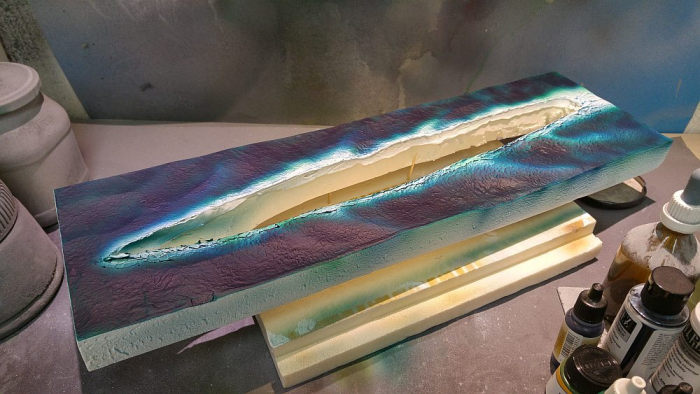 The base
was prepared very early on, after my usual method. It is rather small, as I
wanted to use a standard Trumpeter display box. I prepared a wave pattern beyond
the later base size using a gas burner (making sure I had adequate ventilation),
then made a cutout for the hull and cut the base to size. Some very limited
sanding completed the dirty work. The vessel was wrapped in clingfilm and fit on
the base with acrylic caulking to close gaps remaining after making the cutout.
The base
was prepared very early on, after my usual method. It is rather small, as I
wanted to use a standard Trumpeter display box. I prepared a wave pattern beyond
the later base size using a gas burner (making sure I had adequate ventilation),
then made a cutout for the hull and cut the base to size. Some very limited
sanding completed the dirty work. The vessel was wrapped in clingfilm and fit on
the base with acrylic caulking to close gaps remaining after making the cutout.
The base was then painted with white wall paint in a stippling motion to provide the sligthly irregular surface texture that most closely resembles water. It was later on sprayed first with a green and then a dark blue shade of acrylic model paints, providing a transition between the disturbed water around the vessel and the undisturbed water surrounding it.
This was left to dry for two weeks, to let any residual moisture evaporate.
Then the base was sprayed with several coats of gloss clear from a rattlecan, to seal it and provide the necessary reflective surface. Further wave and wake effects were applied using heavy clear gloss acrylic gel, drybrushed and enhanced with white artist´s oil paint.
The bow wave was further enhanced using a mixture of clear gloss acrylic gel and the small plastic balls meant for use with CA glue. That gives a nice texture, and when drybrushed with white oil paint, a pleasing result.
 Returning
to the vessel proper, there followed a lot of work on various subassemblies, as
usual. I cleared up the various resin parts and those of the white metal parts I
would use, and continued from there. Mostly the model was built OOB, I only
replaced the massive bridge with a scratchbuilt replacement that would look
transparent. I made a bridge roof patterned after the kit part I had removed,
and fashioned framing for the bridge windows from wire and styrene stock.
Returning
to the vessel proper, there followed a lot of work on various subassemblies, as
usual. I cleared up the various resin parts and those of the white metal parts I
would use, and continued from there. Mostly the model was built OOB, I only
replaced the massive bridge with a scratchbuilt replacement that would look
transparent. I made a bridge roof patterned after the kit part I had removed,
and fashioned framing for the bridge windows from wire and styrene stock.
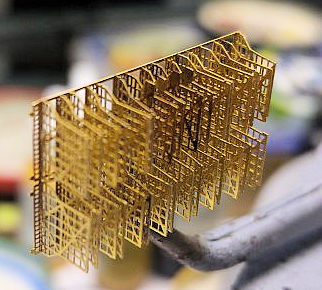 The
most daunting tasks were building the type 965 radar array and the Seaslug
launcher. In retrospect, building the radar array was the easier task. It only
needed nerves of steel and truckloads of patience. You get a front face and a
rear face, and several dozens of mesh screen plates, which need to be mounted at
defined angles to the front face so they can be glued to the rear face in the
right spot. Plus some additional framing on all four sides. It´s doable, but it
takes stamina.
The
most daunting tasks were building the type 965 radar array and the Seaslug
launcher. In retrospect, building the radar array was the easier task. It only
needed nerves of steel and truckloads of patience. You get a front face and a
rear face, and several dozens of mesh screen plates, which need to be mounted at
defined angles to the front face so they can be glued to the rear face in the
right spot. Plus some additional framing on all four sides. It´s doable, but it
takes stamina.
The launcher assembly is a
different kettle of fish. The construction sequence takes up a full page of the
instructions, to begin with, and still doesn´t quite tell you all. Plus the
stuff didn´t fit the way it was supposed to, at least when I tried assembling
it. I disassembled the entire thing twice, as in putting it into a dish with
acetone, and using a flame to remove any remaining CA glue. I
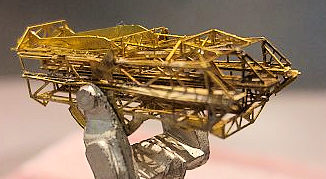 also
cut apart the crucial horizontal planes #48 and 49 at some point. That was
supposed to be done at the end, and when I had to restart the whole thing, I
really had a mound of very iffy parts before me.
also
cut apart the crucial horizontal planes #48 and 49 at some point. That was
supposed to be done at the end, and when I had to restart the whole thing, I
really had a mound of very iffy parts before me.
Somehow I managed to get the thing together and mounted it on its white metal base. I solemnly vowed not to tackle something like that in the foreseeable future again.
Many items were easily built and detailed, and I did make some good progress. I had some problems locating all the vent grills, and one or two were left over, but they were easily attached, with some annealing helping with the curved ones. Building the masts and adding the very iffy PE yardarms was quite a daunting task, same as somehow getting the white metal ECM arrays mounted via very iffy PE braces to the mast. The whole yardarm arrays ended up very weak, which boded ill for rigging them.
In my project, I now needed to decide how to model the missile damage. Looking through the images available to me, I saw that at the moment I wanted to show, most debris was gone, including the hangar door, the big hole in the deck had been plated over, and a provisional railing had been rigged where the safety netting had been destroyed. The hangar roof had buckled upwards from the blast, and the fire had left traces in and around the hangar and on the hull side.
I buckled the hangar roof by carefully applying heat to the part and then pressure from below the roof. That worked quite well, but may have warped the part a bit, so I needed to make it fit to the main deck again. The plating over the hole was made from thin styrene stock. I omitted the port Sea Cat launcher and added a PE disc to where its mounting hole was. I had to reposition the starboard launcher when mounting it, as in its original position it would interfere with the Sea Cat director platform.
All this took time, as usual, but having the most difficult parts out of the way, I grew more optimistic. Failure in building the 965 radar or the Seaslug launcher would have meant I could trash the entire project. No pressure ...
| COLORS & MARKINGS |
I have had really annoying
problems over several years with paint liftoff. Ships need masking for their
boot toppings, so I was always concerned I hadn´t properly prepared or primed
the model. I washed my kit parts in soapy water, I lightly sanded my surfaces, I
de-greased them using white spirit and the like, I tried various primers, it
happened again and again. It also didn´t matter whether I used acrylic or
solvent-based
 primers,
I simply wasn´t sure about the outcome. After reading about it on the M2 forum,
I got myself Badger´s Stynylrez primer in black and white, and tried it on this
project. It did work like a charm, and I had no liftoff whatsoever on the hull
sides. I was very much relieved about that.
primers,
I simply wasn´t sure about the outcome. After reading about it on the M2 forum,
I got myself Badger´s Stynylrez primer in black and white, and tried it on this
project. It did work like a charm, and I had no liftoff whatsoever on the hull
sides. I was very much relieved about that.
After priming, the hull was sprayed black, the boot topping masked off, and then the lower hull sprayed red. With the black below the red, that made for a dull brick red which I much preferred over a brighter hue. The hull sides and remaining vertical surfaces were sprayed Vallejo Model Air Pale Blue Grey, equivalent to RLM 76, which looks quite all right to me, thank you very much.
The wooden deck areas were sprayed from my dwindling supplies of JPS IJN Deck Tan, and then a dark brown oil wash was applied, which left a convincing result. The flight deck was sprayed Vallejo Model Air Grey Primer, and the green deck areas in vallejo Model Air Camo Green.
| FINAL BITS |
Basic painting done, I painted the missile damage. I wanted to do that prior to attaching the rear superstructure, as the hangar was better accessible that way. Using various greys and reddish browns from the airbrush and some hues in artist´s oils, I tried to get reasonably close to the impression the reference images gave. I also started weathering the hull, using artist´s oils.
That done, I started assembling the main components. As mentioned above, I needed to do some adjusting and filling on the two superstructure blocks, but it was doable. From then on, it was a succession of adding parts from large to small and from the model´s center to its periphery. I only tackled the forecastle and quarterdeck once the rest was completed, in order to minimize the risk of accidental damage. The PE railings were prepainted on the fret, then cut from the fret, bent to shape, glued with Zap a Gap medium CA glue, and then handpainted, rendering the individual bars in a darker grey.
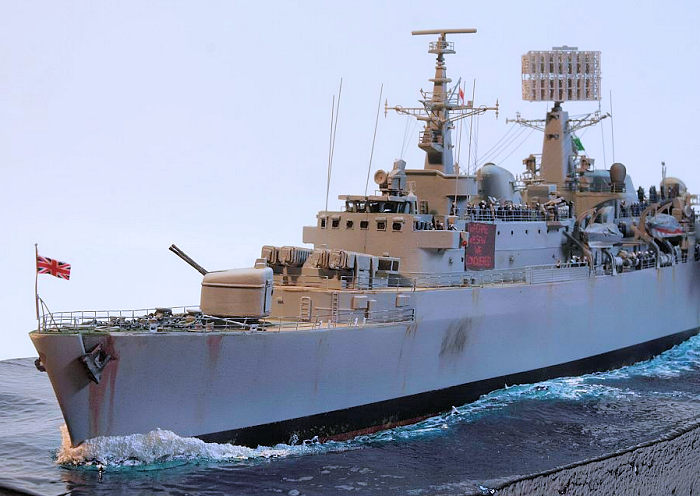 The
rigging was a most nerve-wracking experience, as the yardarms were so flimsy. I
used .1 mm wire from Albion Alloys for the antenna wires and UNI Caenis for the
signal lines. I was tremendously relieved when it was over.
The
rigging was a most nerve-wracking experience, as the yardarms were so flimsy. I
used .1 mm wire from Albion Alloys for the antenna wires and UNI Caenis for the
signal lines. I was tremendously relieved when it was over.
I almost ran out of railings, and would have appreciated a bit more spares, but luckily had some stashed from previous projects.
The vessel flew several flags on the occasion, one of them a large Welsh flag from her main mast. As I had no Welsh flag, I printed it on cigarette paper, and painted that paper white from the backside. Upon folding the flag, it looked quite all right. The other two flags were sourced from my stash, as I botched the kit flags. They stuck to my fingers, let it remain at that ...
Rather late in the project, I realized that I needed more liferaft canisters, so I ordered a batch from Shapeways. These items look the part and are easy to work with. I needed to fashon some supports for the canisters from scratch, which was anything but a big deal. Some additional PE items found their way to the rear of the bridge wings and the long inclined ladders leading to the aft missile deck.
Having finally added all the bits and pieces, I started adding the crew, using the very good NorthStar figures. It must be about a hundred of them, surely less than there were in real life, but I hope they do convey the look of the reference image. That done, I very carefully glued the two pièces de résistance to the model, the masttop radar array and the missile launcher.
That done and secured, I added a good flat acrylic coat of forgetfulness to the model, hopefully obliterating most of the numerous blemishes. That dry, I added glazing to the bridge window frames, and as the final touch added the bridge roof, when the glazing was cured clear. The model was then placed on its base, its fit was so snug I did not glue it to the base.
| CONCLUSIONS |
 This was
the single most expensive model kit I ever built so far. There were moments when
I thought I would not be able to adequately complete crucial subassemblies, and
the entire project looked in danger. So I would rather recommend the kit to
those with some experience and the dedication to complete intricate and
demanding PE assemblies.
This was
the single most expensive model kit I ever built so far. There were moments when
I thought I would not be able to adequately complete crucial subassemblies, and
the entire project looked in danger. So I would rather recommend the kit to
those with some experience and the dedication to complete intricate and
demanding PE assemblies.
I did enjoy the process of researching and building and finding solutions to numerous detail issues, and I am quite happy with the completed result. A Falklands veteran I know told me the model did look right to him, and brought back the memories, some of them uncomfortable. I was very impressed with the candid account by the late Ian Inskip of his war experience and the trauma he brought home with him, and seeing the model I feel I can relate to the mixture of emotions the crew must have felt in this moment of release.
| REFERENCES |
Books:
McCart, Neil: County Class Guided Missile Destroyers. Maritime Books 2014
Inskip, Ian: Ordeal by Exocet: HMS Glamorgan and the Falklands War. Chatham Publishing 2002
Internet:
http://countyclassdestroyers.co.uk/design.htm
http://www.seaforces.org/marint/Royal-Navy/Destroyer/County-class.htm
https://en.wikipedia.org/wiki/County-class_destroyer
6 July 2018
Copyright ModelingMadness.com
Thanks to www.dragonmodelsusa.com for the preview kit. You can find this kit at your favorite hobby shop or on-line retailer.
If you would like your product reviewed fairly and fairly quickly, please contact the editor or see other details in the Note to Contributors.
Back to the Main Page Back to the Previews Index Page Back to the Review Index Page